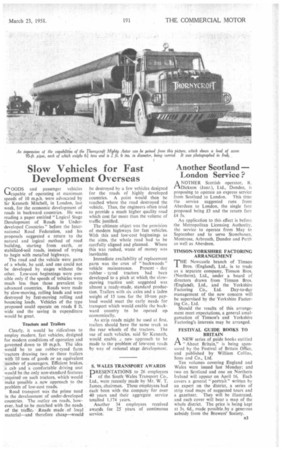Slow Vehicles for Fast Development Overseas
Page 37

If you've noticed an error in this article please click here to report it so we can fix it.
GOODS and passenger vehicles capable of operating at maximum speeds of 10 m.p.h. were advocated by Sir Kenneth Mitchell, in London, last week, for the economic development of roads in backward countries. He was reading a paper entitled "Logical Stage Development of Roads in Underdeveloped Countries" before the International Road Federation, and his proposals suggested a return to the natural and logical method of road building, starting from earth, or stabilized-soil roads, instead of trying to begin with metalled highways,
The road and the vehicle were parts of a whole, he said, and one could not be developed by stages without the other. Low-cost beginnings were possible only if the speeds of vehicles were much less than those prevalent in advanced countries. Roads were made by slow-moving, rolling toads and were destroyed by fast-moving rolling and bouncing loads. Vehicles of the type proposed could operate on roads 8 ft." wide and the saving in expenditure would be great.
Tractors and Trailers
Clearly, it would be ridiculous to employ modern, fast vehicles, designed for modern conditions of operation and governed down to 10 m.p.h. The idea would be to use rubber-tyred farm tractors drawing two or three trailers with 10 tons of goods or an equivalent riurnber of passengers. Efficient brakes, 'a cab and a comfortable driving seat would be the only non-standard features required on such tractors, which would make .possible a new approach to the problem of low-cost roads.
Road transport was the prime need in the develonrnent of under-developed countries. The outlay on roads, however, had to be matched•with the-needs of the traffic.. Roads made. of local material—and therefore cheap—would
be destroyed by a few vehicles designed for the roads of highly developed countries. A point would then be reached where the road destroyed the vehicle. Thus, the engineers often tried to provide a much higher quality road which cost far more than the volume of traffic justified.
The ultimate object was the provision of modern highways for fast vehicles. With this and low-cost beginnings as the aims, the whole road had to be carefully aligned and planned. Where this was rushed, waste of money was inevitable.
Immediate availability of replacement parts was the crux of "backwoods" vehicle maintenance. Present day rubber tyred tractors had been developed to a pitch at which, the slowmoving tractive unit suggested was almost a ready-made, standard production. Trailers with six axles and a laden weight of 15 tons for the 10-ton payload would meet the early needs for transport which would enable the backward country to be opened up economically.
As strip roads might be used at first, trailers should have the same track as the rear wheels of the tractors. The use of such vehicles, said Sir Kenneth, would. enable e„ new approach to be made to the problem of low-cost roads by way of rational stage development.
S. WALES TRANSPORT AWARDS
DRESENTATIONS to 26 employees 1 of the South Wales Transport Co., Ltd., were recently made by Mr. W. T. James, chairman. These employees had each been with the company for over 40 years and their aggregate service totalled 1,174 years.
Another 34 employees received awards for 75 years of continuous service.




















































































